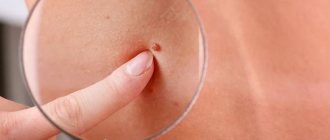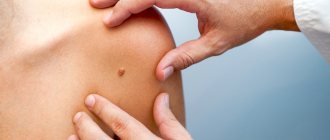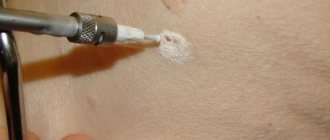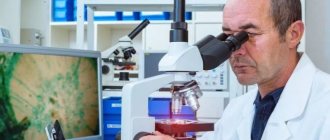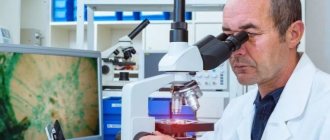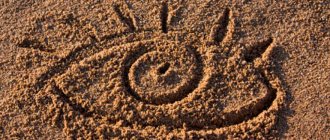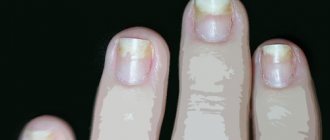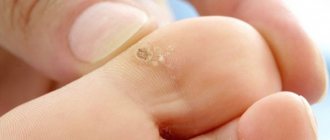They are often confused with dry calluses due to their external similarity and localization features. Incorrect treatment or ignoring the problem leads to relapses, severe pain, and proliferation of tumors. Getting rid of plantar warts is recommended in clinical settings. Doing this at home is much more difficult.
What do plantar warts look like?
Plantar warts, or, colloquially, thorns, are benign manifestations of several strains of the human papillomavirus. Unlike their “brothers”, which usually occupy the more delicate skin of the hands, neck or face, these tend to go where the epidermis is rough and subject to constant friction.
They are discovered by accident. The main symptom is a sharp stabbing pain in the foot or between the toes, as if from a pebble or splinter caught inside. Upon examination, raised round keratinized plaques of white or yellowish color with depressions in the center become visible. Sometimes dark spots appear inside - damaged capillary vessels of the dermis. The surface of the skin in the affected areas is usually rough or glossy smooth. There is no characteristic papillary pattern on it. This is the main external difference between papillomas and ordinary corns. Dry calluses always retain their skin pattern.
When pressing on the spine, a sharp pain is felt. The keratinized cells grow deeper, irritating healthy tissue as they move. In advanced cases or when trying to pick off such a “callus,” blood appears. Damage to warts often provokes the development of secondary infections, which leads to suppuration. Such neoplasms do not pose an oncological danger, but cause severe physical discomfort.
How does the removal itself take place?
At the appointment, the doctor clarifies complaints, the duration of the disease, conducts an examination, and clarifies the presence of concomitant diseases and allergies to medications.
If the diagnosis is confirmed and there are no contraindications, intervention is performed. After treating the skin with an antiseptic, local anesthesia is administered with a thin needle. This may cause some pain (like any injection), but then the removal itself is completely painless. After making sure that the anesthetic has worked, the doctor destroys the wart with a radio wave scalpel. After removal, the wound is treated with fucorcin and a bandage is applied. The entire intervention takes 2–3 minutes.
Where do plantar warts come from?
HPV enters the body from the outside. Pathogens love moist environments. You can become infected by wearing someone else's shoes, neglecting the rules of hygiene in pedicure salons, baths, saunas or swimming pools. A virus suppressed by the immune system may not manifest itself for years. But in a weakened body, viral particles begin to divide very quickly. The propagation of plantar strains is facilitated by:
- increased sweating of the feet;
- uncomfortable tight shoes;
- microcracks in the skin;
- fungal infections of the feet;
- circulatory disorders due to joint deformation: arthritis, arthrosis, flat feet.
Within the epidermis, the virus first infects the basal layer. Then it provokes the proliferation of keratinized particles, forming characteristic hard plaques on the skin.
The main symptom of this form of HPV is severe pain while walking. The roots reaching the lower layer of the dermis constantly injure the nerve endings. Many patients have to give up their usual shoes and use thick, soft insoles to alleviate the pain.
Human papillomavirus
This is one of the most common viruses on Earth. Infection can occur in several ways:
- contact and household (through touch);
- sexual (genital, anal, oral-genital);
- in childbirth from mother to child.
The period of development of the disease ranges from several weeks to tens of years, this is explained by the fact that the virus may not manifest itself for a long time, but as soon as the immunity becomes a little weaker, growths immediately appear on the skin and/or mucous membranes. The main danger of this disease is that certain types of HPV are highly likely to cause the formation of a malignant tumor (cancer of the skin or mucous membranes). To make sure that the disease will not lead to the formation of a tumor, it is necessary to undergo examination by a doctor and not self-medicate.
Medicines for plantar warts
The composition of drugs for removing papillomas includes antiviral compounds, immunomodulators or substances that loosen the stratum corneum of the skin. Pathogens that suppress the reproduction include:
- Fluorouracil: 5% cream for topical use, activates protective cells, slows the growth of warts;
- Imiquimod: promotes the production of interferons, prevents further damage to the skin;
- Viferon: gel for external application, has high antiviral activity.
These drugs have virtually no side effects, but at an advanced stage of papillomatosis they are ineffective. To destroy and remove large warts, keratolytics, necrotizing agents, and cryogenic agents are used. All of them require careful handling, as they contain acids, alkalis and other chemically active components. Dermatologist approval is required before use.
Popular remedies for warts:
- Salipod: a patch with salicylic acid, softens the affected layers of the skin, allowing you to remove the wart and get to its root;
- Super celandine: a solution that “burns out” the keratinized layers, promotes necrotization and death of papillomas;
- Cryopharma: a solution in aerosol form, contains a nitrogenous compound that freezes areas of affected tissue.
These medications must be applied pointwise to warts, strictly following the instructions so as not to damage healthy skin. The period of death of warts after their use: from 5 to 20 days. In advanced cases, you need to repeat the procedure. Remains of papillomas must be removed mechanically, and wounds must be treated with iodine solution.
What to do if you accidentally pick off a wart?
It is not uncommon for a patient to accidentally tear off a wart. The doctor will also tell you what to do in such a situation, but before going to a medical facility, you should definitely disinfect the injury site and try to stop the bleeding as quickly as possible. It is important to apply a tight bandage.
Removing warts is a complex medical task, which today involves the use of such hardware techniques as laser destruction , electrocoagulation and cryodestruction. Highly qualified specialists of the NEOMED clinic, who care about both the health and aesthetic condition of each patient, will help you decide whether it is better to remove warts with laser or nitrogen.
Find out the cost of the procedure “Removal of tumors”
Benefits not related to removal technique
- Honest prices.
No hidden fees or intrusive services. Either consultation or removal is paid, strictly according to the price list. You can always check the price with me on VKontakte by sending a photo with a ruler in the background. - Free information support before and after surgery.
If you have any doubts before your visit, you can easily and free of charge by mail or VKontakte. After the operation, you will have my personal phone number, by which you can ask me at any time about what is bothering you. - Fast and convenient:
- Online appointment booking and removal without calls or waiting
- No preliminary tests, dressings, or suture removal required
- Histology results by email
. You can read them on these sites: docplanner.ru (more than 40 reviews), napopravku.ru (24 reviews), vk.com (more than 150 reviews)
What are the symptoms of papillomatosis or warts?
Depending on the type, warts are located in different places on the human body and clinically manifest differently. The ordinary type affects the skin of the fingers and the palm of the hand, which is typical for adolescence. Filiform warts love the skin of the neck, face and armpits. The flat type is common among young people and appears as groups on the facial skin that look and feel hard and smooth.
When the first symptoms appear, a serious question arises: “how to get rid of plantar warts?” After all, in people suffering from excessive sweating, they grow very quickly and can reach up to 2 cm in size. And this kind of scale completely interferes with normal walking.
Cryodestruction method (cryotherapy)
In fact, this method for getting rid of plantar viral warts is very effective in terms of complete cure and 100% elimination of re-infection. Liquid nitrogen freezes the wart and completely destroys it. Watery blisters appear around it, and the wart itself dies. Within a week, the dead layer is rejected, and a slight inflammation appears in its place, which slowly disappears. If the pain is unbearable, you can apply anesthetics.
Removing warts with nitrogen
This is an alternative to laser wart removal. The method is also quite popular, but usually requires several procedures, they are quite painful, and after cryodestruction with liquid nitrogen a painful bubble forms. Therefore, removal of condylomas with liquid nitrogen is recommended only for older children and adults.
Removing warts with nitrogen
Cryodestruction is repeated every 2-3 weeks until the final disappearance of condylomas. Usually 6 sessions of liquid nitrogen treatment are sufficient, but if the wart still persists, other treatment options are considered. In addition, destruction with liquid nitrogen is not suitable in cases where the wart affects the area of the fingers and thighs.
Diagnostics
The differential diagnosis is based on the clinical picture of the specific type of neoplasm, as well as on the study of the anamnesis. The size of the papule, the rate at which it increases in size, the number of formations and other factors are taken into account.
To make a final diagnosis, the patient may be referred for histological examination.
If the appearance of warts is planned to be excluded using destructive methods, it is first important to be tested for HIV, hepatitis and syphilis.
Self-medication is harmful
Do not try to diagnose and treat HPV infection on your own! Firstly, there is a risk of improper use of drugs. Secondly, only a doctor can distinguish papilloma from a malignant tumor. In addition, self-treatment is fraught with consequences.
Today, there are celandine-based preparations on sale that are intended to eliminate warts. Celandine juice is similar in composition to iodine. Therefore, prolonged exposure to the drug causes skin burns. In this case, papillomas are seriously injured and can provoke the development of skin cancer. Cauterization with iodine is even more dangerous - it is more aggressive than celandine. Trying hard to get rid of papillomas with iodine, you can get scars on the skin. Vinegar is no better in this regard. Attempts to bandage warts and papillomas with a thin silk thread often only provoke the growth of these formations.
If you suspect the appearance of warts or genital warts, you should definitely seek advice from a dermatologist, urologist or gynecologist, depending on the location of the source of infection. Only a professional can correctly diagnose the disease and prescribe the necessary treatment.
Causes and types of warts
The growths that cover the skin are the result of infection with a virus. There are more than 100 types of HPV, which contributes to the appearance of warts. The infection enters the human body through skin wounds during contact with a sick person. It is easy to become infected in public places where the virus is transmitted through shared items. The following types of warts are distinguished:
- Vulgar, or simple, growths have a dense structure, a shade close to the color of the skin. Appear on the knees, hands, fingers.
- Flat warts resemble smooth spots with a flat surface that rise slightly above the skin. Usually appear in teenagers.
- Plantar or plantar warts. Their roots penetrate deep into the skin. Outwardly, they resemble hard spots that appear on a person’s feet and cause discomfort while walking. In some cases, the growths protrude strongly above the skin and have a “terry” structure.
- Filiform papillomas visually resemble papillae that grow in length. The color varies from natural to brown, the structure is elastic. These warts have small roots.
- Pointed growths affect the genitals and are distinguished by a conical shape. They can grow quickly, provoking destructive changes in adjacent tissues. When such formations appear, immediate treatment is indicated.
Warts have a characteristic appearance. They are easily differentiated from each other.
The presence of a wart with black roots indicates an old form of the disease. But sometimes this can be a defensive reaction to infection, leading to the spontaneous death of the growth. Blackening of the roots occurs when the treatment is properly selected or when the upper part of the growth is damaged.
Strengthening the immune system
Modern medicine has not yet learned to kill viruses. But an important fact is that HPV carriage is not lifelong. In addition, medicine has a small number of means at its disposal that allow it to remove some of the viruses from the body. The use of these drugs is fully compatible with immunomodulatory therapy.
The amount of virus in the body is directly related to the state of the body’s immunity - the better the immunity, the less virus. Therefore, the most promising way to reduce the concentration of HPV in the body is to strengthen the immune system. For this purpose, a separate course of treatment is carried out, after which the person begins to feel much better.
Finally, there are very effective preparations for topical use - creams, gels, sprays that increase local immunity and reduce the concentration of the virus in the affected tissues.
